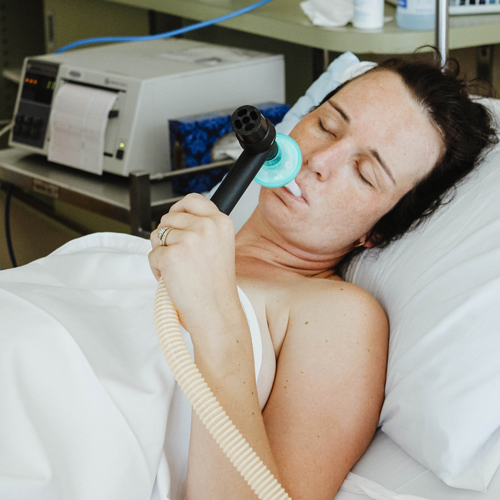
Birthing women denied nitrous oxide ('laughing gas') to relieve labour pain during the COVID-19 pandemic have turned to opioids instead, without any adverse outcomes for mother or child, according to a new study by Australian clinicians.
The study, at Lyell McEwin Hospital in Adelaide, looked at the impact of withholding nitrous oxide (N20), a decision adopted by numerous hospitals worldwide in the past two years due to fears of virus transmission from the aerosol-generating procedure.
Anaesthetist Professor Bernd Froessler, and colleagues from the University of Adelaide and University of South Australia compared patient notes for all 243 women birthing at Lyell McEwin over a seven week period in March/April 2020, half of whom did not have access to N20.
They found that although opioid use "significantly increased" when N20 was withheld, there was no increase in epidural use and no change in labour duration, Caesarean section rates, birthing complications or newborn alertness.
Their findings have been published in the Australian and New Zealand Journal of Obstetrics and Gynaecology.
Nitrous oxide is used by more than 50 per cent of Australian women to relieve pain in labour, followed by epidurals (40 per cent) and opioids (12 per cent), according to the Australian Institute of Health and Welfare.
However, its carbon footprint (representing 6 per cent of global gas emissions, with 1 per cent due to healthcare) has led to a debate in medical circles whether it should be replaced with other methods of pain relief.
Many obstetricians argue that effective pain relief in childbirth should be the priority, particularly given the low percentage of emissions, but the Australian and New Zealand College of Anaesthetists has advocated for a reduction in N20 use in a bid to improve environmental sustainability in anaesthesia.
"Obviously no-one wants to deprive labouring women of adequate and easy pain relief but given there are other analgesic options, including epidurals and opioids, perhaps these could be considered," says Prof Froessler.
UniSA statistician and researcher Dr Lan Kelly says the study results should reassure women that pain relief other than nitrous oxide does not compromise their health or their baby's.
However, in a recent Sydney Morning Herald article, principal midwifery officer at the Australian College of Midwives, Kellie Wilton, said mothers should not be made to feel guilty about their pain relief choices and suggested hospitals could introduce nitrous oxide destruction systems to allow for its ongoing use.
When nitrous oxide destruction systems were introduced in Swedish hospitals, the carbon footprint from the gas was halved.
Notes for editors
COVID-19 infections in pregnancy are associated with an 11 per cent rate of admission to intensive care units, a 26 per cent pre-term birth rate and a 2 per cent neonatal mortality rate, hence the safety concerns over fears of virus transmission.
Nitrous oxide was introduced for labour relief in the 1960s and is commonly used in the UK, Canada, Finland and Australia.
According to a recent report in Australasian Anaesthesia, using nitrous oxide during a four-hour labour creates a carbon footprint equivalent to driving an average car for 1500 kilometres, whereas an epidural is equivalent to driving 6 kilometres.
The Lyell McEwin study paper can be accessed at: https://obgyn.onlinelibrary.wiley.com/doi/10.1111/ajo.13577






